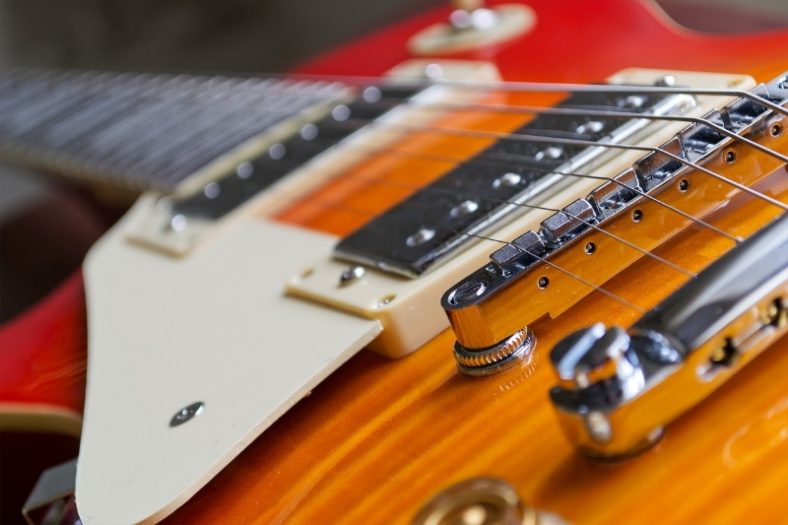Why Strings Buzz On Guitar (7 Reasons)

String buzz is a common occurrence among guitar players. It can happen due to various reasons such as poor technique, low action, insufficient neck relief, humidity, and other reasons.
A “buzzing” sound is always an irritating noise, whether it is coming from a fly or a washing machine. But, the most irritating for us guitarists is when it comes from our instruments’ strings or frets.
One of the most frustrating yet common problems that guitarists suffer from is the string buzz. It drastically affects the guitar’s tone, messing up with your performances or recordings. However, luckily, it is an extremely common issue, often with easy fixes and solutions.
Contents
What is String Buzz?
The string buzz or fret buzz is the common problem of a string hitting a fret when strummed or plucked. When the string vibrates, it repeatedly comes into contact with a fret, creating that unwanted buzzing sound.
The string buzz can occur with open strings as well as on some particular frets when certain notes are played. There can be many reasons behind the problem, but luckily, most of the reasons have an easy fix that can be solved quickly.
1. Fret Leveling
All of the fret levels should be even with each other on a healthy guitar. If there is even one fret that is not, it will most probably create the buzzing sound.
Uneven frets may have different reasons. First of all, it can be a factory issue, meaning the frets may have been installed poorly during the manufacturing process. Another reason might be the unevenly worn frets through the years of playing.
You can check your fret levels easily with something that has a straight edge, like a card or a ruler. Put the card or the ruler on top of 3 frets starting from the first and going up to the last. Be sure to cover the whole fret instead of covering just a part.
If the card or ruler rocks back and forth at any position, here is your uneven fret. Suppose you spot an uneven fret; the best solution is to leave it to the professional hands of luthiers for them to fix or change the uneven fret.
2. String Action
If the string action is set too low then buzzing will most likely occur.
Although a nice low-string action is desirable for many guitarists, it shouldn’t be set to too low, as when the strings are too close to the fretboard, they often strike to the frets, creating that disturbing buzzing sound.
You can adjust your guitar’s string action using a couple of different ways. First, you can try to raise the saddle’s height on the buzzing string. You can also try adjusting the truss rod, but do it in small increments, like a quarter turn at a time.
3. Neck Relief
If the neck relief is too low the strings will be too close to the neck and will most likely strike the frets when plucked, producing a buzzing sound.
Neck relief is all about the tension on the neck caused by the strings. So, if you are using a lower gauge string set or a drop tuning, they might be pulling the neck too lightly, reducing the tension. That means the neck relief will also be too low, and the strings will be too close to the neck, causing the strings to strike the frets when plucked.
If you think that is the issue, try using heavier gauge strings or a higher tuning so that the tension will raise and the neck will have a more front-bow, causing the strings to go higher.
If you want to go on with your tuning and string set, then try adjusting the action according to your strings and tuning.
4. Humidity
As guitars are instruments made of wood, humidity plays a significant role in many problems that occur with them.
If a guitar is kept in a room without enough humidity, its wood will dry out, causing its top to sink in or drop down. If the top of your instrument drops down, this will cause the bridge and the strings to go lower, resulting in the strings getting too close to the frets and creating a buzzing sound.
The optimal humidity condition for your guitar is around 40%-50% humidity at all times. Try to keep your guitar in a room with these humidity levels to avoid any problems, including the string buzz.
5. Poor Technique
Before blaming the external conditions or your guitar for any problem, you have to check your playing technique, as most of the problems originate from the player.
Poor technique is the root of many issues that may occur with the guitar, including the string buzz.
If you are not pressing the strings hard enough, it may cause them to buzz, so try to push down harder. If that feels too uncomfortable, try using lighter strings.
Where you are pushing down the fret is also essential. It should be ok if you are pushing down the middle of the fret or somewhere closer to the fret itself. However, if you are pushing down high above the fret, it will most certainly create a buzz.
Another reason could be that you are strumming the strings too hard, causing them to strike the frets. Try strumming the strings lighter and at a proper angle, making them vibrate parallel to the frets instead of towards them.
6. New Strings
Another common reason for the string buzz is newly installed strings.
The new strings take their time before breaking in, and in the meantime, they may create string buzz, even if the gauge is the same. But, do not worry; with time and some playing, the strings will break in, and the problem will be solved.
If the new strings you are installing have different gauges, then you will have to adjust your action according to the new set as the neck tension will be different with different gauge strings.
7. Warped or Twisted Neck
A warped or twisted neck is probably one of the worst things that can happen to your guitar that causes the strings to buzz.
Mainly because of humidity and temperature changes, your guitar neck’s wood gets affected drastically, getting warped or twisted like a corkscrew.
As you can imagine, when the guitar’s neck is warped or twisted, frets on the one side get lifted while the ones on the other side get lowered. This causes some strings to hit the frets and buzz or choke out, especially while bending.
Unfortunately, there is not much to do for a twisted or warped neck with amateur hands. If your neck is a bolt-on neck, you can always change it with a new neck. Otherwise, you have to take it to a luthier, seeing what he can do to save your instrument.
What to do to Prevent or Fix String Buzz?
The string buzz problems mainly occur because of improper setup. You have to adjust your action correctly when you buy a new guitar and whenever you start using a new string set with a different gauge. Checking the action from time to time is also important, even if you do not change any strings.
The second most common reason is poor technique. If your strings are still buzzing after the action is appropriately set, it is most probably you are not fretting in the right way, or you are strumming or plucking the strings too hard. So, try to recreate your playing habits as explained in the previous section to avoid the string buzz problem.
If these are not enough to prevent the string buzz, your guitar might have an uneven fret or a warped/twisted neck, which in that case, you will have to take it to a luthier. Protect your guitar against humidity and temperature changes to prevent this problem.
How Much String Buzz is Normal?
The answer depends on each individual guitarist’s preferences. Some players want the action as low as possible, so a bit of string buzz does not disturb them. But, some others find even the slightest buzz irritating and distracting, which leads them to set their string action higher.
If a note’s sustain is almost non-existent because of the buzz, and/or if you can hear the buzz from your amp, these indicators mean the buzz is too much.
If a note only buzzes during your first attack to the note and the buzz does not affect the normal sustain, then this level of string buzz can be acceptable.
Summary
The string buzz can be an annoying issue as there can be many reasons behind it, starting from your playing technique to string action and even extending to a twisted neck. But, 95 percent of the cases are easily fixable with a bit of adjustment on the action and a little care when strumming the strings.
If you are also suffering from this issue, start the diagnosis process from your technique, moving up to the string action adjustment and changing the string gauge. If the problem still persists, which most likely will not, then it is time to take your instrument to a doctor.





